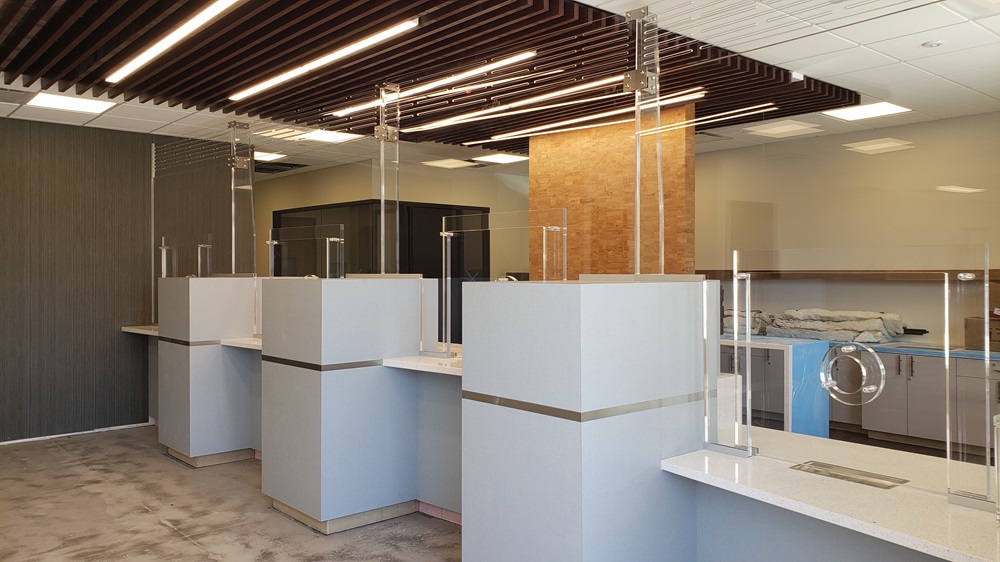If you're planning your first bulletproof system, think through these five questions before speaking with a bulletproofing consultant:
1. What Type of threat do you need to protect against?
It takes different levels of ballistic material to stop shots from a .9mm and an AK-47. Likewise, it takes different styles of systems to deter a sniper compared to a smash-and-grab bandit.
2. What area of your building do you need to secure?
Different materials and designs work better in indoor and outdoor applications. The number of access points, the height of ceilings and lengths of counters, the materials of the walls, all have an impact on system design.
3. How Will You Use the barrier?
A barrier with high traffic–many transactions, many deliveries, many visitors, a loud and bustling lobby–poses different challenges than a barrier mounted at the end of a quiet hall with only the occasional visitor turning in paperwork.
4. What are your aesthetic goals?
Some businesses want unobtrusive bulletproof reception windows and bullet resistant doors that blend in with every other door in the building; others want the system to clearly announce itself and act as major a deterrent.
5. What limitations are there to the delivery and installation?
Your system arrives in a semi-truck strapped to pallets that need to be moved with a forklift. Installing on a second floor with narrow halls in a building at the end of an alley is challenging–knowing about that early will give TSS time to find solutions.
Getting the Details of Your Project Right is the First Step
Once you have these details clear in your head, then you will have a very productive conversation with a TSS consultant. That consultant will walk you through the options that suit your space and application, arrange to get accurate measurements, have drawings prepared as you work through the approval process.
It surprises most new customers to learn that the trickiest aspect of any bulletproof system is the doors. Any member of Jim’s team can recall countless occasions when a customer has been absolutely confident that they need a door hinged on the right and swinging into the secured area, only to take one look at the drawings and realize that’s impossible because of the furniture layout, or the way two halls come together, or fire code, or one of a million other tiny details.
“Doors get people all the time,” Jim notes. “It’s why we made this bulletproof door checklist, to help people think through it before they commit.”
It may seem like a simple matter, but TSS bulletproof doors are entirely custom made–which is how they can get a seamless fit and smoothly integrate your preferred hardware, from standard keyed locks and panic bars to multi-entry computer-controlled electric strike access systems. Changing the direction of swing or how the door is hung often necessitates redesigning the door from scratch.
Smooth Production and Installation Preparation
Once the plan is squared away and approved in writing, the process rolls very smoothly. All TSS bullet resistant barrier systems and components are fabricated on-site).
In order to assure tight tolerances among all of a barrier’s components, TSS relies on a highly tech-driven engineering workflow. Because of the job batching process, many projects go into production immediately upon receiving your approval. This is great for delivery times but bad for last minute changes; always double check all drawings carefully prior to approval.
While your system components are being fabricated, there are a few things you can take care of to be ready for installation. The most important of these are:
- Establish a single point of contact within your organization to answer any questions about the system, delivery, or installation. Having a single point of contact assures faster turnarounds and fewer miscommunications.
- Prepare for installation: Make arrangements within your organization to receive shipments, clear out spaces, grant after-hours access to installers, and so on.
Keeping Installation Easy
The installation itself is a breeze, rarely taking more than a single evening. Even complex systems can be installed over a weekend. While some buyers may elect to do their own installation–especially with a “single-site” or “single element” installation, like putting in a simple transaction window–Jim is quick to point out that it’s easy to bite off more than you can chew.
“These are unfamiliar materials to most people,” he explains. “What you’ve got to keep in mind is that these materials can’t be treated the same way as regular building materials. First off, they’re heavy. It’s very easy to damage your drywall or framing by leaning a large ballistic acrylic window against it. A bulletproof door, if leaned against a wall, can actually deform under its own weight. Also, some of the materials–especially the transparency–can be badly marred by things like paint thinner or lacquer thinner, which are no problem for regular window glass.”

